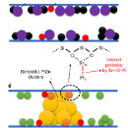
A research team has developed a synthesis procedure to modulate the exact interaction between platinum (Pt) and tin (Sn) in subnanometric Pt clusters confined in MFI (Mobil-type five) zeolite to achieve optimal catalytic performances. The catalyst showed an initial propane conversion of ~20% and after 70 h the propane conversion decreased very slowly to ~17%, demonstrating the outstanding performance of this new catalyst. In-situ X-ray absorption spectroscopy (XAS) experiments were performed in the CLÆSS beamline at the ALBA Synchrotron.

For the first time, an international team of scientists recreated in the lab the molecule that allows the tsetse fly to feed on blood. It’s a powerful yet small anticoagulant with a unique and strong binding to thrombin, the key enzyme of the coagulation pathway. X-ray diffraction measurements at two synchrotron facilities ––ALBA and ESRF–– were instrumental to understand the structure and the mechanism of action of this molecule, which suggests it is also a promising platform for designing improved anticoagulant drugs.

More than 170 participants from all Europe met up virtually for the third League of European Accelerator-based Photon Sources (LEAPS) Plenary meeting. The event has been hosted by the ALBA Synchrotron, whose director, Caterina Biscari, will continue as Chair of LEAPS in 2021.

Discover our services for SMEs! Remember that till 21st December 2020, small and medium companies can ask for funded beamtime in different European light sources thanks to EU CALIPSOplus project

A study led by scientists from the XALOC beamline of the ALBA Synchrotron reports an in-depth structural analysis of bacterial proteins involved in conjugation: Rap and Rco, at various levels of atomic detail. They have demonstrated that Rap tetramerization is induced by peptide binding, through a novel “foot-2-foot” interaction, not previously seen in other proteins of the Rap family. Tetramerization hampers Rap-Rco interaction, releasing Rco, which is a repressor protein, and thereby blocking conjugation, the transfer of genetic material between bacteria.






